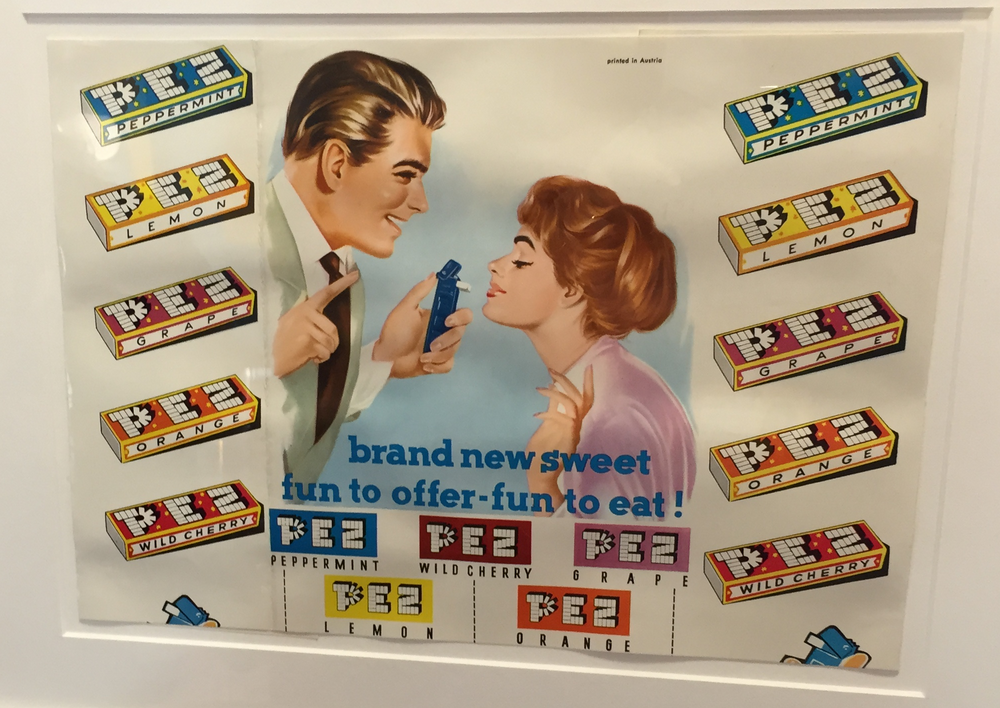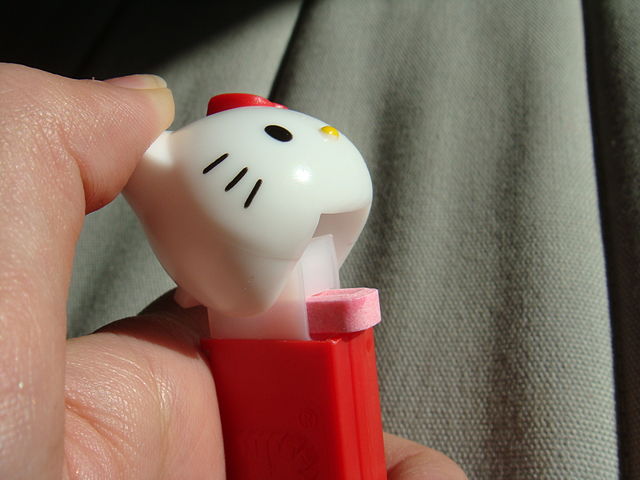How Smoking Gave PEZ a Boost

At first glance, the image above — from a 1950s advertisement — is probably related to smoking. The man is offering his lighter to his lady friend, allowing her to light her cigarette and release all the good things (and tar and tobacco and death, too) which come from a drag. But if you look a bit more carefully, you’ll notice that there’s something off in the image — the cigarette is touching the lighter, but it isn’t quite in the woman’s mouth. In fact, the cigarette isn’t touching anything but the lighter — its other end is floating in mid-air.
That’s because the lighter isn’t a lighter, and the cigarette isn’t a cigarette.
It’s PEZ — coming out of a PEZ dispenser. But the smoking imagery isn’t an accident.

If you’re not familiar with PEZ, they are fruit-flavored mints which are shaped like little bricks. They’re overrated as candies go, and it’s basically impossible for someone with even slightly below average dexterity to fill the dispensers. (Trust me.) But because the dispensers come in basically every single character you can think of, they’re kind of fun for kids (whose parents are filling the dispensers anyway), and have become collectables. And as a result, you can get PEZ at toy stores, grocery stores, and a ton of other places where you’d normally not find either toys or minty candies.

But PEZ’s initial popularity had nothing to do with the allure of a pink mint firing out of the neck of a disembodied Hello Kitty, as seen above. Rather, it came from its inventor’s ahead-of-the-times pet peeve. Edward Haas III, an Austrian, invented PEZ in 1927, with some minimal commercial success — enough to stay in business, but hardly enough to become an internationally known candy. In the 1940s, Haas had an idea to brand the product while also doing good. Even though it’d still be a decade or two before the Surgeon General of the United States would issue the office’s first report on the harms of smoking, Haas — an early anti-smoking advocate — figured that smoking was, in part, driven by a desire to have something in one’s mouth, and Haas wanted to turn PEZ into an alternative to lighting up. In 1948, he re-introduced PEZ with a cigarette lighter-like dispenser (it was previously sold in tins) and the slogan “Rauchen Verboten, PEZ-en Erlaubt” — “No Smoking, PEZing Allowed.”

By most accounts, the campaign worked (despite the ridiculous slogan) — at least in Europe. At the time, PEZ was still peppermint-only, and the product didn’t fare well in the United States. By 1952, Haas entered the U.S. market with a wide range of fruit flavors and, three years later, began to put character heads on the dispensers. (Santa Claus, one of the first characters, is still one of the most popular.) Sales picked up and the company never turned back.
The “smoking alternative” line disappeared around the same time, and few if any people credit PEZ with helping them break the cigarette habit.
 Bonus Fact: PEZ is short for “Pfefferminz,” the German word for Peppermint.
Bonus Fact: PEZ is short for “Pfefferminz,” the German word for Peppermint.
From the Archives: Why Diet Coke Loves Mentos: Mints meet science.
Take the Quiz: Pick the “real” Harry Potter treats. None are likely to stop you from smoking.
Related: May the Force be minty.
